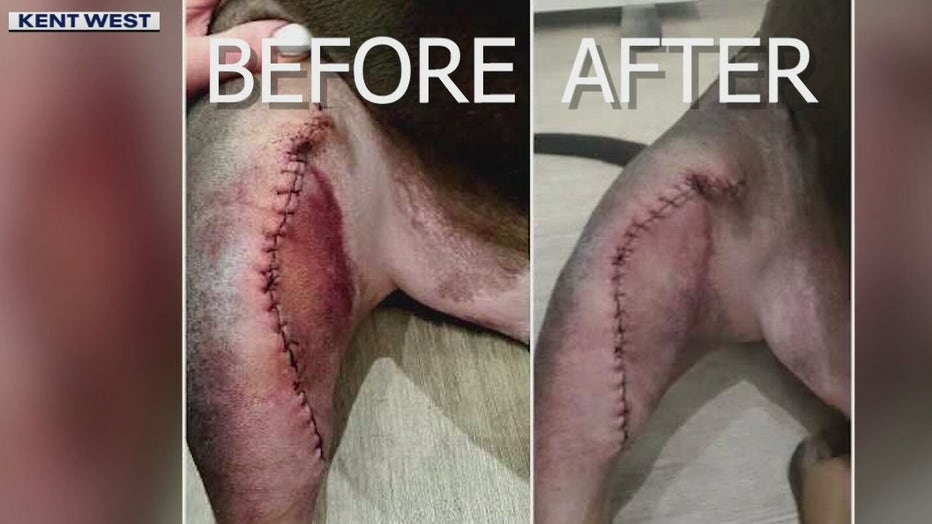Animals undergo cryotherapy treatment at Phoenix clinic for all different kinds of pain

Animals undergo cryotherapy treatment at Phoenix clinic for all different kinds of pain
Pet owners are allowing their animals to experience alternative forms of pain management through cryotherapy at a Phoenix clinic, instead of the traditional medicine route. Veterinarians should sign off on the therapy, however.
PHOENIX - For decades, people have relied on cryotherapy. Now, our four-legged friends are feeling the benefits.
Simply put, cryotherapy is the super-cooling of the body for therapeutic purposes. It's been used to relieve muscle pain, sprains and even swelling after surgery. It's most commonly used to accelerate recovery in athletes.
In the past few years, SportCryo in the Phoenix-area has used it to treat animals as well.
The company opened its doors seven years ago.
Owner and trained and certified cryo-tech, Kimberly Klein, has treated everything from chronic pain to isolated injuries.
"We basically pull the inflammation out of the affected area. Whether it’s a chronic injury or acute injury, it relieves the congestion, puts fresh healthy oxygenated blood to the area and accelerates recovery," she explained.
Klein's patients range in age and ability, and as of late, breed and species.
"One of my clients years ago said, ‘My dog just injured her shoulder and I don’t know what to do, they’re giving me drugs. She’s drugged-out, she’s not eating,’ and I went, ‘What about cryotherapy for animals?’ I was kind of shooting in the dark at that point. I didn’t know I hadn't worked on animals and it worked unbelievably well," Klein said.
Animals suffer from aches, like arthritis, soreness and injuries, just like people do.
Just like Riley.
"He is five. He had both his back legs in terrible condition. He couldn’t walk on them because the kneecaps were not in the right place. They were behind his legs and stuff and so he got surgery on both legs," Klein explained.
Pandora is a one-year-old Doberman Pinscher. When she "Shes here because at about six months she jumped off the couch kind of injured her right shoulder," she explained.
"When she favors her right shoulder, she will pull her leg up and doesn't want to walk," Klein said.
These dogs, along with others, are now regular clients at SportCryo.
Klein says treatment times and intensity vary.
"Obviously a little teeny tiny chihuahua is going to be a tiny little area and there’s not a lot of fur. For that, I’m going through four-ish minutes. If I’m working on 120-pound Alaskan Malamute, obviously there’s a lot that I’m going through. It can be upwards of 11 to 15 minutes depending on the area. Horses can be even longer than that because I’ve got a lot of dense muscle mass and hide I’m going through," she explained.
While most human clients are treated in the cryo chamber, Klein uses a specialized tool for localized treatment on people and that is what works best on the animals.
"Anything post-surgical. We’ve got internal sutures, we’ve got zippers and brackets. We can’t have any moisture applied to them. Being that this is completely dry, we get the job done of accelerating recovery while protecting that area of injury," Klein said.
Results differ, but these images of a full cranial cruciate ligament repair, taken 24 hours apart after two treatments, show how cryotherapy can work.

"I can spend $5,000 on a surgery to fix an issue that you may never have to fix if you catch that issue early enough, and fix it. It’s all catching issues sooner than later, you know?" Klein said.
It's becoming more obvious how much people love their pets and as they seek alternative treatments for themselves, they're doing the same for the animals that mean so much.
One treatment costs about $35. Klein suggests consulting with your veterinarian to make sure cryo is best for your animal.
More information can be found here.
Related Stories:
- Some Prescott Valley area residents say ambulance response times are too long – if one shows up at all
- What happened to 'Jubi'? FBI, Scottsdale PD's search continues for missing man with autism
- 'I just can’t compete': Phoenix housing market has man living in RV, burned out on home search

